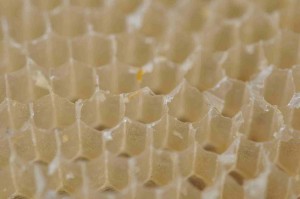Ask Phil
Phil Craft
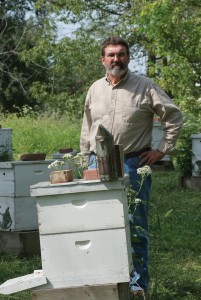
Send your questions to Phil at
phil@philcrafthivecraft.com
www.philcrafthivecraft.com
A beekeeper in Wisconsin writes:
I’m a first time writer.
I’m also a first year beekeeper but I’ve hosted bees on my property for three years and subscribed to Bee Culture for two years before starting the two hives I have now. These were started this Spring from (2) 3# packages w/Italian queens. Both hives are doing great – I have double brood boxes (FULL) and two deep supers one of which is at about 60# but the current dearth has left the second super’s foundation (wood frames, pre-waxed Rite-Cell w/extra wax and sprayed w/sugar water and stimulant) with no comb yet.
(…) The reason for my question(s) is that – I’m having a blast keeping bees! I intend to use all new equipment and I’ve just finished branding, painting & numbering woodenware to very quickly go from two hives this year, to 25-30 in 2016.
I’m also going to be trying some of the basic queen rearing next year so getting “mini-mating” & full size nuc frames combed out, etc. without brood would be great.
Phil replies:
In your email you asked a series of questions related to methods of encouraging comb production. I will answer those individually in the body of this article, but first I would like to talk generally about honey comb. It all starts with the production of bees wax. Honey bee workers are equipped with wax glands located in the ventral (bottom side) of their abdomen. In the same way that insects are made up of three segments – head, thorax, and abdomen – the abdomen of a honey bee worker is sub-divided into nine segments. The wax glands are located between the fourth and seventh segments. Wax is produced as a liquid, and then hardens into small flakes when the liquid is exposed to the cooler air in the hive. The bee uses its legs to move flakes to its mouth where the wax mixes with secretions from salivary glands and is worked into comb. Wax production and comb building are age dependent activities. Though honey bees can make wax when they are as young as two days old, their production ability peaks at 10 days and lasts until they are about 20 days old, at which time they move on to other tasks.
Of course, in a Langstroth hive, comb is built on foundation. You mentioned that you used plastic. Plastic versus wax foundation is one of those issues which has no clear cut answer and so sparks endless debate and discussion on beekeeping forums. The arguments come down to the undoubted convenience of plastic versus the feeling that wax is more natural and bees will draw comb out on it more quickly. My own experience is that, in a strong nectar flow, bees will draw out plastic foundation very readily. Might they draw comb out on wax a little more quickly? Perhaps, but installing wax foundation takes time and effort on my part – time during which my bees could have been producing and filling comb. Sometimes, especially in the Spring when things are happening quickly in my beeyard, I find it very handy to stop by my local bee supplier and pick up preassembled frames with plastic foundation. I can even store extras outside in my beeyard – not a good idea for frames with wax foundation which is susceptible to damage at high temperatures. Overall, I prefer wax. I guess I just like the way it smells, and maybe the bees draw it out better late in the season. However, I often make use of plastic when convenience and time are my primary considerations. It’s another tool available to beekeepers.
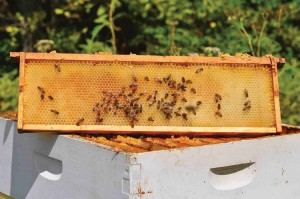
Light honey combs.
Much more important than the type of foundation used is a condition you alluded to in your question: nectar flow or dearth. Beekeepers have long noted that the onset of the Spring nectar flow is accompanied by the appearance of clean white wax, seen in repairs to existing comb, as new burr comb, and as newly drawn comb on foundation. The timing is not coincidental. Honey bees do not produce new comb just to keep the young bees busy; they make it when they need more space for nectar and pollen or to rear more bees. Though, fortunately for us, bees store honey far beyond the requirements of the colony, they do not draw out large amounts of comb unless they have an immediate need for it. If they draw out a few frames and have nothing to fill them with, they stop. Boxes placed on a hive in a time of dearth will not yield the combed out, broodless frames that you are hoping for.
One circumstance in which a colony will build comb very rapidly is that of a newly housed swarm. I have known large swarms placed on new foundation to draw out a deep box in a matter of days. This frenzy of wax production is due to three factors. First, the colony has an urgent need for cells for both for egg laying and food storage. Second, swarms contain a large percentage of young bees less than 10 days old. Third, most swarming occurs during nectar flows. However, keep in mind that, though a large, captured swarm can make you a lot of comb quickly, it will also fill it almost as quickly.
When it comes to maximizing comb production, we might look at the techniques used by beekeepers who market comb honey. Their business requires fresh comb for every harvest, so these folks should be experts on the subject. One thing they do is to make use of strong, captured swarms. Another is to partially mimic the conditions of a swarm by crowding bees from a two story hive into a single brood box, then placing supers of foundation over a queen excluder above the box. The combination of a lot of bees to collect nectar and the sudden need for cells to store it in results in a rapid drawing of comb. Of course, crowding colonies in this way can cause them to swarm in earnest – a common problem among comb honey producers.
Yet another method they use is to create a “shook swarm,” or artificial swarm. The procedure involves moving a strong hive to a new location within the same bee yard and replacing it with a new hive consisting of a single brood box with frames of foundation. Then half to two thirds of the bees, along with the queen, are shaken from the strong hive into the empty box and topped with a queen excluder and honey supers. This constitutes the artificial, shook swarm. Placing it on the site of the original hive ensures that it will inherit that colony’s entire field force, further strengthening, and crowding, the new colony. Since there are no cells for the queen to lay eggs in, the bees concentrate on drawing comb. They will quickly draw out the brood box and turn their attention to the frames above the queen excluder. Meanwhile, the original hive will be fine in its new location. It can be re-queened or, if it was a strong colony already in swarm mode and making queen cells, it will produce its own. With lots of capped and uncapped brood and a new young queen, it should rebound, and may even be capable of producing a super or two of honey.
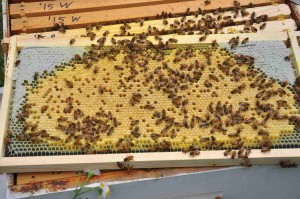
A healthy brood pattern with honey in the corners.
The same strategy can be used with deep hive bodies as honey supers. After extracting the honey, a beekeeper will be left with extra deep frames of clean comb for future use in new nucs or to replace culled frames in brood boxes. One word of caution: a number of years ago, I used several deep hive bodies with new foundation as honey supers – not using any special technique – but just placing them over strong honey producing colonies. While this worked well, I did not enjoy pulling the deep honey supers, which weighed about a hundred pounds each. Though I don’t necessarily trace my back problems back to this experiment, it took place prior to my back surgery, and I have not used deeps as honey supers since.
Another, very simple, technique to encourage comb building or to supplement any of the above methods is to add young bees to a wax building colony. When brood frames from another hive are shaken in front of the wax builder, the older, foraging bees will return to their original hive, whereas the young bees, which have never flown, will enter the hive and remain. What all of these strategies have in common is that they concentrate a strong population of bees in an area without sufficient comb for egg laying and food storage. Those are also the conditions which often precipitate swarming. The other common thread is that none of them is effective in the absence of a nectar flow.
Has anyone combined the right genetics, equipment, timing and placement to configure a colony that will willingly “pound on the wax” and build comb on pre-waxed plastic foundation? And if so, was it done without depleting the health or viability and will to survive and grow (expand & thrive).
I do not know of any research into using genetics to increase comb building, but the conditions which promote it are well understood as discussed above.
To keep the comb clean for first time use – Can the hive be kept “broodless”, by sequestering a large queenless package, and using the pheromone products that simulate a laying queen.
Trying to maintain broodless colonies for any length of time would be counterproductive as well as unnecessary. Remember, the life span of a honey bee emerging in the summer is less than 40 days, and the period of maximum wax production is even shorter – about 10 days. For efficient comb production a colony needs a constant re-supply of newly emerged workers, and for that you must have a fertile queen. Even captured and “shook” swarms which build new comb quickly, can only do so for a short period. During the time between making the first cells to receive eggs and the emergence of those bees, the population of such colonies is slowing declining, with some bees dying of old age and no new ones emerging. While this is not readily noticeable in a large population, it is not sustainable in the long term.
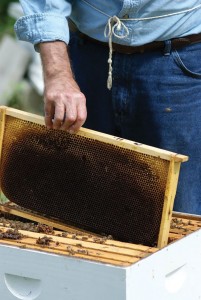
Dark brood combs.
If what you are looking for is clean looking wax, all you need to do is put the foundation to be drawn over a queen excluder. What makes wax dark (aside from some natural darkening that occurs over time) is propolis, cocoons and other waste products from rearing brood. Compare the dark oval in a frame of brood comb that has a normal laying pattern to the light comb from a honey super. Wax from a super which has never contained brood will remain light in color for many years.
Can feeding comb producing colonies with plenty of “high test” syrup and stimulant help?
Feeding with sugar syrup made from equal parts granulated sugar and water is helpful – especially when installing natural or artificial swarms on foundation with no comb – in that it sustains the colony until it is able to gather sufficient nectar and pollen and make comb to store it in. However, it has its limitations. If you continue to feed after placing honey supers, the bees will simply fill them with sugar syrup, which is not honey, and of no use to you, . Better to wait for a nectar flow and let them fill as many supers as they can with honey. Since bees only make comb at the rate at which they need it, you can either have new comb with sugar syrup or new comb with honey. You will not get new comb only.
If by stimulants you mean nutritional supplements, I am not aware of any research which indicates that they promote the production of comb except in as much as they may contribute to the overall health of the colony.
How long (long enough (?) to get a couple of batches of deep brood & deep honey frames combed out?)
The amount of time it takes depends on the strength and health of the population, the proportion of bees in the right age range (10 to 20 days old), and the nectar flow. It is possible for a strong colony, especially a large recently hived swarm, or “shook swarm”, to draw out a deep full of foundation in less than two weeks under optimal conditions.
Could the bees be fooled into drawing out comb before installing a queen, and letting them build up normally?
If bees were installed in a hive without a queen or brood, it would not take long for the colony to develop laying workers, which is a BIG problem. Removing a queen from a strong hive with plenty of brood might cause the colony to channel its energy into producing comb since less would be required for caring for larvae. Pheromones from the brood would suppress the workers’ urge to lay for a while. However, as the brood emerged the cells would be filled with nectar, leaving no place for the queen to lay when she is reintroduced into the hive, and creating another complication. Also, if the placement of a new queen is delayed too long, laying workers would again be the result.
What about combining a comb building colony with another young colony w/exist queen to give them more resources?
It still comes down to population, bees of the right age, and a natural nectar flow or feeding. Combining colonies, purchasing larger packages, and combining packages as well as the methods described above will all produce strong colonies capable of rapid buildup given sufficient food sources. As before, monitor for signs of swarming. If you lose a queen and half your bees after creating an artificially strong colony, you haven’t gained much.
If working with a “super hive” could you periodically shake off and stock the “comb builder” with enough bees to work comb and then go back into the existing big hive to “recover” from all the work? If so, how often (many times) in a “winter shortened” season do you think you could get the bees to do this and still thrive?
There is no question of recovery, since bees age out of the comb building phase of their lives and start doing other things, such as foraging. You can remove bees, but you cannot later re-use those same bees for comb building; they are too old. Shaking out bees from one hive in front of a second is a viable strategy for building up comb in the latter, as I described above. It could probably be done every few weeks without harming the stronger hive. Keep in mind that both hives need young bees to draw out comb and to tend to the queen and brood, and both also require foragers to bring in food and water. Perhaps instead of thinking in terms of supers and comb builders, you should concentrate on keeping both hives strong, well nourished, and disease/parasite free. You seem to be doing well so far.
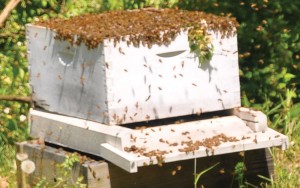
Overpopulating a hive to draw out new comb.
A few last comments. I very much appreciate your enthusiasm, your questions, and your efforts to think outside the box. This fever is one of the reasons that I enjoy working with new beekeepers. The fascination with honey bees comes about because they are so . . . well . . ., fascinating. I am sometimes on the road for a week or more at a time, speaking and visiting with beekeepers. I often find myself being re-infected with the fever through my contacts with new beekeepers especially, and I cannot wait to get back home and into my own hives. I may not even have any particular tasks to do; I just want to be with the bees. However, new beekeepers need to remember that we have been practicing the art and science of beekeeping in very much the same way since shortly after Reverend Langstroth discovered bee space and designed his new hive over 150 years ago. It ain’t rocket science, but there is much to learn. It reminds me of trying to teach my kids to drive, or of anyone learning a new sport. It’s not enough to learn all the rules and practice the mechanics. To be really good means being able to react in certain situations without having to think things through, because you’ve seen it and done it so many times before. I make these comments as a response to your plans to increase from two to 25 or 30 hives and start queen rearing in your second year of beekeeping. I have known a number of beekeepers whose zeal was quashed when disaster followed trying to expand too much too quickly. There is a huge difference between taking care of two hives, and 25. For that matter, there is a huge difference between managing two hives from packages and two mature hives. My advice, based on more than 15 years of helping new beekeepers, is to go more slowly, perhaps increasing to ten or twelve hives next year, and adding six or eight the next. I want to see both your enthusiasm and your success continue.






